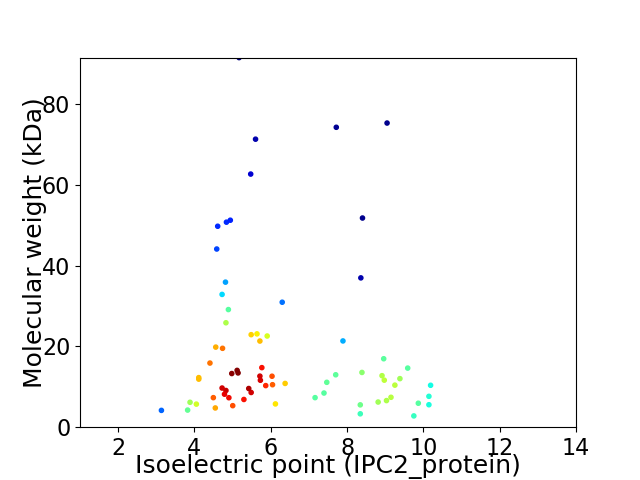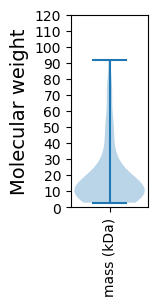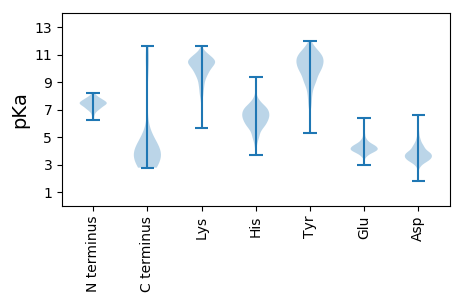
Arthrobacter phage DrManhattan
Taxonomy: Viruses; Duplodnaviria; Heunggongvirae; Uroviricota; Caudoviricetes; Caudovirales; Siphoviridae; Manhattanvirus; Arthrobacter virus DrManhattan
Average proteome isoelectric point is 6.4
Get precalculated fractions of proteins

Virtual 2D-PAGE plot for 72 proteins (isoelectric point calculated using IPC2_protein)
Get csv file with sequences according to given criteria:
* You can choose from 21 different methods for calculating isoelectric point
Summary statistics related to proteome-wise predictions



Protein with the lowest isoelectric point:
>tr|A0A3G2KFJ9|A0A3G2KFJ9_9CAUD Uncharacterized protein OS=Arthrobacter phage DrManhattan OX=2419955 GN=54 PE=4 SV=1
MM1 pKa = 7.84DD2 pKa = 6.37LDD4 pKa = 5.38DD5 pKa = 6.63DD6 pKa = 4.55VDD8 pKa = 4.5LEE10 pKa = 4.29LDD12 pKa = 3.26EE13 pKa = 5.78RR14 pKa = 11.84EE15 pKa = 4.53YY16 pKa = 11.63VCEE19 pKa = 4.05TCNLIHH25 pKa = 6.85WRR27 pKa = 11.84GAPDD31 pKa = 3.65PCDD34 pKa = 3.41RR35 pKa = 11.84SS36 pKa = 3.51
MM1 pKa = 7.84DD2 pKa = 6.37LDD4 pKa = 5.38DD5 pKa = 6.63DD6 pKa = 4.55VDD8 pKa = 4.5LEE10 pKa = 4.29LDD12 pKa = 3.26EE13 pKa = 5.78RR14 pKa = 11.84EE15 pKa = 4.53YY16 pKa = 11.63VCEE19 pKa = 4.05TCNLIHH25 pKa = 6.85WRR27 pKa = 11.84GAPDD31 pKa = 3.65PCDD34 pKa = 3.41RR35 pKa = 11.84SS36 pKa = 3.51
Molecular weight: 4.24 kDa
Isoelectric point according different methods:
Protein with the highest isoelectric point:
>tr|A0A3G2KFL1|A0A3G2KFL1_9CAUD Uncharacterized protein OS=Arthrobacter phage DrManhattan OX=2419955 GN=66 PE=4 SV=1
MM1 pKa = 7.24IHH3 pKa = 7.03GNRR6 pKa = 11.84DD7 pKa = 3.49DD8 pKa = 4.92LLWLAGLLEE17 pKa = 4.55GEE19 pKa = 4.75GTFDD23 pKa = 3.26AHH25 pKa = 6.21RR26 pKa = 11.84GKK28 pKa = 10.74YY29 pKa = 9.13PRR31 pKa = 11.84IRR33 pKa = 11.84LAMTDD38 pKa = 3.13RR39 pKa = 11.84DD40 pKa = 4.23VVGRR44 pKa = 11.84AASLMDD50 pKa = 3.63SKK52 pKa = 10.97IRR54 pKa = 11.84LSLHH58 pKa = 4.88VAPAKK63 pKa = 7.62PTWHH67 pKa = 6.42TEE69 pKa = 3.46ISGEE73 pKa = 3.92RR74 pKa = 11.84AAEE77 pKa = 3.97IMRR80 pKa = 11.84QILPFMGTRR89 pKa = 11.84RR90 pKa = 11.84SGRR93 pKa = 11.84IAEE96 pKa = 4.34VLGTHH101 pKa = 6.81HH102 pKa = 7.03FRR104 pKa = 11.84QKK106 pKa = 11.2AVIEE110 pKa = 4.31AGKK113 pKa = 10.63GSTPGPRR120 pKa = 11.84VSRR123 pKa = 11.84PAGVAKK129 pKa = 10.34PLTAAA134 pKa = 4.22
MM1 pKa = 7.24IHH3 pKa = 7.03GNRR6 pKa = 11.84DD7 pKa = 3.49DD8 pKa = 4.92LLWLAGLLEE17 pKa = 4.55GEE19 pKa = 4.75GTFDD23 pKa = 3.26AHH25 pKa = 6.21RR26 pKa = 11.84GKK28 pKa = 10.74YY29 pKa = 9.13PRR31 pKa = 11.84IRR33 pKa = 11.84LAMTDD38 pKa = 3.13RR39 pKa = 11.84DD40 pKa = 4.23VVGRR44 pKa = 11.84AASLMDD50 pKa = 3.63SKK52 pKa = 10.97IRR54 pKa = 11.84LSLHH58 pKa = 4.88VAPAKK63 pKa = 7.62PTWHH67 pKa = 6.42TEE69 pKa = 3.46ISGEE73 pKa = 3.92RR74 pKa = 11.84AAEE77 pKa = 3.97IMRR80 pKa = 11.84QILPFMGTRR89 pKa = 11.84RR90 pKa = 11.84SGRR93 pKa = 11.84IAEE96 pKa = 4.34VLGTHH101 pKa = 6.81HH102 pKa = 7.03FRR104 pKa = 11.84QKK106 pKa = 11.2AVIEE110 pKa = 4.31AGKK113 pKa = 10.63GSTPGPRR120 pKa = 11.84VSRR123 pKa = 11.84PAGVAKK129 pKa = 10.34PLTAAA134 pKa = 4.22
Molecular weight: 14.64 kDa
Isoelectric point according different methods:
Peptides (in silico digests for buttom-up proteomics)
Below you can find in silico digests of the whole proteome with Trypsin, Chymotrypsin, Trypsin+LysC, LysN, ArgC proteases suitable for different mass spec machines.| Try ESI |
 |
|---|
| ChTry ESI |
 |
|---|
| ArgC ESI |
 |
|---|
| LysN ESI |
 |
|---|
| TryLysC ESI |
 |
|---|
| Try MALDI |
 |
|---|
| ChTry MALDI |
 |
|---|
| ArgC MALDI |
 |
|---|
| LysN MALDI |
 |
|---|
| TryLysC MALDI |
 |
|---|
| Try LTQ |
 |
|---|
| ChTry LTQ |
 |
|---|
| ArgC LTQ |
 |
|---|
| LysN LTQ |
 |
|---|
| TryLysC LTQ |
 |
|---|
| Try MSlow |
 |
|---|
| ChTry MSlow |
 |
|---|
| ArgC MSlow |
 |
|---|
| LysN MSlow |
 |
|---|
| TryLysC MSlow |
 |
|---|
| Try MShigh |
 |
|---|
| ChTry MShigh |
 |
|---|
| ArgC MShigh |
 |
|---|
| LysN MShigh |
 |
|---|
| TryLysC MShigh |
 |
|---|
General Statistics
Number of major isoforms |
Number of additional isoforms |
Number of all proteins |
Number of amino acids |
Min. Seq. Length |
Max. Seq. Length |
Avg. Seq. Length |
Avg. Mol. Weight |
|---|---|---|---|---|---|---|---|
0 |
13088 |
23 |
837 |
181.8 |
19.8 |
Amino acid frequency
Ala |
Cys |
Asp |
Glu |
Phe |
Gly |
His |
Ile |
Lys |
Leu |
|---|---|---|---|---|---|---|---|---|---|
12.401 ± 0.35 | 0.604 ± 0.108 |
6.479 ± 0.348 | 6.494 ± 0.317 |
3.14 ± 0.152 | 8.458 ± 0.339 |
1.796 ± 0.165 | 4.134 ± 0.28 |
4.202 ± 0.248 | 8.794 ± 0.23 |
Met |
Asn |
Gln |
Pro |
Arg |
Ser |
Thr |
Val |
Trp |
Tyr |
|---|---|---|---|---|---|---|---|---|---|
1.948 ± 0.157 | 2.781 ± 0.211 |
5.394 ± 0.314 | 2.659 ± 0.194 |
7.251 ± 0.444 | 5.478 ± 0.24 |
6.472 ± 0.36 | 7.144 ± 0.268 |
1.711 ± 0.127 | 2.659 ± 0.184 |
Most of the basic statistics you can see at this page can be downloaded from this CSV file
Proteome-pI is available under Creative Commons Attribution-NoDerivs license, for more details see here
| Reference: Kozlowski LP. Proteome-pI 2.0: Proteome Isoelectric Point Database Update. Nucleic Acids Res. 2021, doi: 10.1093/nar/gkab944 | Contact: Lukasz P. Kozlowski |
